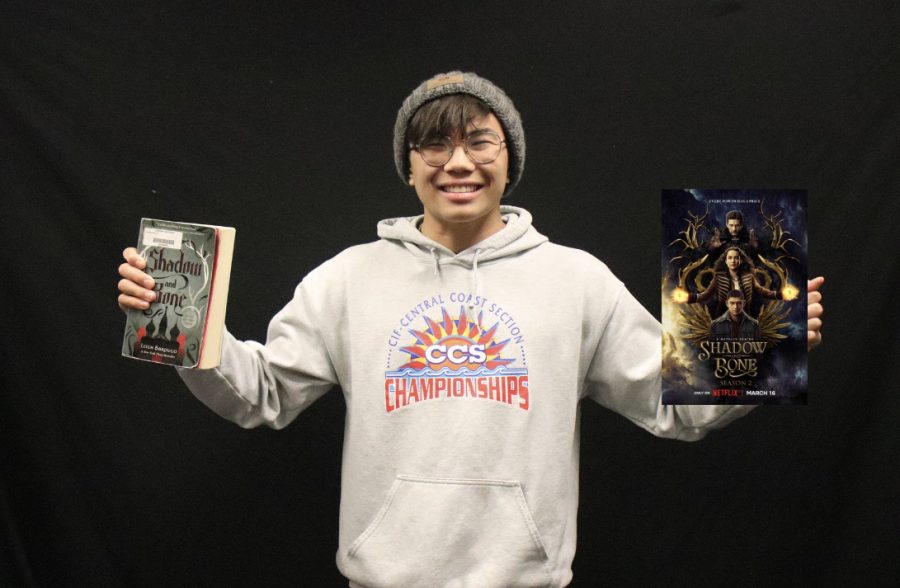Shadow and Bone: a worthy adaptation?
Graphic Illustration by Meera Nambiar
Based on the “Grishaverse” books by Leigh Bardugo, Netflix’s “Shadow and Bone “tells the story of compelling characters, yet in an unfortunately crammed second season.
April 10, 2023
The highly anticipated release of the second season of Netflix’s “Shadow and Bone,” an adaptation of the Grishaverse books written by author Leigh Bardugo, succeeds in developing a popular fantasy world that appeals to both newcomers and loyal book fans. Despite this, the fantasy drama series has a few missteps throughout its storytelling and production. While “Shadow and Bone” received high viewership and remains immensely popular on Netflix due to its excellent visuals and music, the quality of the show falls victim to inconsistent writing, rushed plotlines, cuts from source material and incoherent character development.
The Grishaverse centers around orphan mapmaker Alina Starkov living in the fictional nation of Ravka. During her time in Ravka’s army, she awakens the ability to control light to save her childhood friend, inadvertently becoming an immensely influential figure. As the first “Sun Summoner,” she bears the responsibility of being the savior of the oppressed people in Ravka. The series follows two primary recurring plot arcs: Alina’s journey and the adventures of the Crows, a band of misfit criminals united by both greed and comradery.
“Shadow and Bone” adopts a classic trope in fantasy: the so-called “chosen one.” This trope remains popular in fiction due to its power in generating empathy from audiences for these characters, evidenced by the success of countless stories centered around a single “chosen” character. This idea resonates with audiences by implicitly placing them in the main character’s shoes and guiding them along with the main character’s journey, as the idea of suddenly gaining enormous power and influence appeals to many.
The first season of “Shadow and Bone” adapts the first book of the Grishaverse series by the same name and layers this with a show-exclusive story arc for the Crows featured in later books. The second season of the show adapts the second and third books of the original trilogy along with parts of the first and second books of the “Six of Crows” duology. The first season of the show slightly deviates from the plotline of the original book series to better suit an eight-episode series format. The second season, however, attempts to adapt more from the books, crowding over two books of content into one season.
The result of the enormous amount of adapted content is a messy and often incohesive narrative that throws too many plotlines together at once. Because the show has to adapt two entire novels covering nearly 1,000 pages of source material and an a plot line from a different book for the Crows in just eight episodes, the story is forced to jump between multiple story arcs and character groups at a rapid pace, often resulting in confusion and an overall disorganized plot.
The overall production value of the show across both seasons is highly regarded by audiences. The show excels in every department of production, as it includes a captivating soundtrack composed by Joseph Trapanese, stellar sets and costume design, a versatile and talented cast, and overall high-quality computer-generated imaging. While there are a few questionable moments of visual effect quality in the second season, the general reception of the show’s visuals has been positive.
The high-profile cast portrays excellent performances throughout each episode of the series. Headliner fan-favorites such as Ben Barnes as General Kirigan and Kit Young as Jesper deliver enthusiastic and book-loyal likenesses while implementing their own unique charms with their acting, while television novices Jessie Mei Li as Alina Starkov and Archie Renaux as Mal Oretsev achieve convincing and empathetic renditions of their characters.
The story’s greatest strengths lie in its fantastic worldbuilding. The Grishaverse is a complex and layered environment that includes multiple nations, races, languages and forms of magic all unique in their own ways. Despite the vast complexity of the story’s setting, the show overall manages to effectively guide viewers in understanding the world of the Grishaverse through good worldbuilding and pacing. However, due to the enormous amount of elements from the story that needs to be squeezed into the shorter time frame of the show, key ideas are often left unexplained and consequently result in confusion for those who haven’t read the books. Concepts such as the world’s magic and the societal infrastructure, such as the different cities and environments, are occasionally poorly established and leave audiences unable to smoothly follow the plot. This likely unintentional bias toward the readers of the original series creates a divide among the audience and lowers the quality of the show as a result.
While the first season of Shadow and Bone managed to succeed as a well-rounded and interesting adaptation that captivated viewers in a unique fantasy world, the second season ultimately fails to live up to the expectations set by its predecessor, though it continues the journey of its compelling characters and overall well-rounded production.



































































